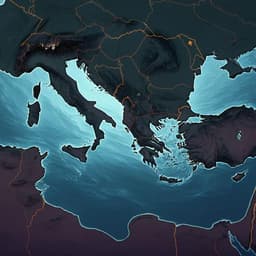
Earth Sciences
Prehistoric human migration between Sundaland and South Asia was driven by sea-level rise
H. L. Kim, T. Li, et al.
Discover how rapid sea-level rise from the Last Glacial Maximum to the mid-Holocene reshaped Southeast Asia's coastal landscape and influenced human migration. This groundbreaking study merges paleogeographic mapping and genomic analysis, revealing the impact of environmental changes on population dynamics. Conducted by a team of researchers including Hie Lim Kim, Tanghua Li, and Benjamin P. Horton, it uncovers the earliest recorded forced migration due to sea-level rise.
~3 min • Beginner • English
Introduction
The study examines how the transition from the Last Glacial Maximum (~26,000–21,000 years ago) to the mid-Holocene (~6000 years ago), during which global mean sea level rose ~135 m with rapid meltwater pulses superimposed on a secular rise, impacted human demography in equatorial Southeast Asia. Sundaland, a vast exposed continental shelf including the Malay Peninsula, Sumatra, Borneo and the Philippines, was inundated as sea levels rose. Modern humans have inhabited Sundaland since ~70,000–50,000 years ago, with present-day descendants including Andamanese, Malaysian Negritos, and Philippine Negritos. Prior work using mtDNA, Y chromosome, and genotyping suggested climate-driven demographic changes but lacked the resolution of whole-genome sequencing. This study integrates high-resolution paleogeographic reconstructions of sea-level change since the LGM with whole-genome data from a wide range of Southeast and South Asian ethnicities to assess how sea-level rise shaped population structure, splits, and migrations, highlighting Southeast Asia as uniquely suitable due to major land-area reduction and continuous human occupation.
Literature Review
Previous studies have linked post-LGM climate change to demographic shifts in Southeast Asia using mitochondrial DNA, Y-chromosome data, and genotyping arrays, suggesting impacts on Sundaland populations but with limited resolution and sometimes contradictory conclusions regarding sources of admixture in South Asian Austroasiatic speakers. Research on Philippine populations hypothesized climate-driven differentiation using genotyping, while earlier genetic and linguistic analyses debated whether Daic speakers or other Southeast Asian groups contributed ancestry to South Asian Austroasiatic populations. This study extends geographic and population scope, uses high-coverage whole-genome sequencing for unbiased demographic inference, and employs a 3D glacial isostatic adjustment model to reconstruct sea-level histories, addressing gaps and inconsistencies in prior literature.
Methodology
Paleogeography and sea-level reconstruction: The authors used the ICE-6G_C global ice history model and the HetM-LHL140 3D Earth model to infer global mean sea-level magnitude and rate at 500-year increments from 26,000 years ago to present. They incorporated far-field sea-level index points, including from the Sundaland Shelf and Singapore, and generated paleotopography maps (every 500 years) to quantify land-cover change and percentage land loss since the LGM. Present-day topography (ETOPO1) and modelled relative sea levels were combined following Peltier (1994, 2004) to reconstruct paleotopography. The timing and characteristics of meltwater pulses MWP1A and MWP1B were contextualized with global coral and sediment records.
Genomic data and processing: The study analyzed 763 high-coverage whole-genome sequences from 59 ethnic groups (GenomeAsia 100K pilot; 33,047,521 biallelic SNPs). SNPs were filtered for >2% missingness, MAF <0.01, and LD r^2 > 0.2, leaving 1,141,813 SNPs for population structure analyses.
Population structure and admixture: Principal Component Analysis (PLINK 1.9) and ADMIXTURE (K=4–20; 10 runs; CLUMPP for consistency) were used to infer ancestries; X-chromosome ADMIXTURE assessed sex-biased admixture (haploid=female:23). Y-chromosome and mtDNA haplogroup frequencies were summarized from prior annotations.
Phylogenetic and admixture modelling: Treemix (rooted on Andamanese; 100 iterations; window sizes 1000 and 2000 SNPs; consensus via PHYLIP) and qpGraph were used to model population relationships and test two-way (and some three-way) admixture for designated admixed groups (South Asian Austroasiatic, Mainland Southeast Asians, Tibeto-Burmans), excluding outlier/admixed individuals (n=630 used).
Demographic inference and migration timing: MSMC/MSMC2 estimated effective population size trajectories (four haplotypes per population) and split times between population pairs (eight haplotypes per pair). Populations analyzed included Paniya (Dravidian), Birhor (South Asian Austroasiatic), Gujjar (Indo-European), Kensiu (Malaysian Negrito), Aeta (Philippine Negrito), Igorot (Austronesian), and Dai (Mainland Southeast Asian). MSMC-IM fitted isolation-with-migration models to MSMC outputs to infer time-varying migration rates and split times (coalescence rate threshold 0.5), with 4–5 replicate runs per comparison. Parameters: mutation rate 1.25×10^-8/site/generation; generation time 29 years; chromosome 6 excluded due to potential phasing errors.
Population density estimation: Effective population size estimates were combined with reconstructed regional land area (Island vs Mainland Southeast Asia) to estimate temporal changes in population density since the LGM.
Key Findings
- Sea-level history and land loss: Global mean sea level rose from −122 m (22 ka) to ~1 m (6 ka), punctuated by MWP1A (14.5–14.0 ka; peak rate ~46 mm/yr) and MWP1B (11.5–11.0 ka; ~22 mm/yr). Sundaland’s land area decreased by ~50% from LGM to mid-Holocene. Land area reduced by ~18% by the end of MWP1A (loss of Palawan–Borneo land bridge) and a further ~19% by the end of MWP1B (loss of Sumatra–Malay Peninsula land bridges); minimum area at ~6.5 ka.
- Population structure: Eleven population groups identified. Andamanese and Negrito groups (except Ati) showed minimal admixture and high homozygosity, indicating long-term isolation.
- Malaysian Negrito ancestry: Substantial Malaysian Negrito ancestry was detected in Mainland Southeast Asians and South Asian Austroasiatic groups. PCA placed South Asian Austroasiatics closer to Malaysian Negritos than to other South Asians. ADMIXTURE (optimal K=7) showed Malaysian Negrito components in these groups.
- Sex-biased admixture: Malaysian Negrito ancestry proportion in South Asian Austroasiatics was lower on the X chromosome (1.3% ± 2.8) than autosomes (7.4% ± 2.9), indicating male-biased gene flow; consistent with Y/mtDNA patterns and prior reports of Southeast Asian Y haplogroups in South Asian Austroasiatics.
- Admixture modelling: qpGraph best-fit models: South Asian Austroasiatics as a 2-way admixture of Dravidians (71%) and Malaysian Negritos (29%); Mainland Southeast Asians as Austronesians (96%) and Malaysian Negritos (4%).
- Demographic trajectories and splits: MSMC indicated multiple population splits ~15–13 ka among Kensiu (Malaysian Negrito), Aeta (Philippine Negrito), and the common ancestors of Igorot (Austronesian) and Dai (Mainland SEA), coincident with MWP1A; Igorot–Dai split ~11–10 ka, coincident with MWP1B. South Asian Austroasiatics showed a dramatic Ne increase 12–7 ka, consistent with admixture.
- Timing and direction of gene flow: MSMC-IM inferred increased migration between Kensiu and Birhor ~12–9 ka, and between Kensiu and Dai ~12–8 ka; no comparable signal between Birhor and Dai/Igorot/Aeta, indicating that the Southeast Asian ancestry in South Asian Austroasiatics derives directly from Malaysian Negritos, not via Mainland Southeast Asians.
- Population size and density: Southeast Asian populations (except Igorot) expanded 4–7× by ~11–6 ka relative to LGM. Despite greater land loss in Island SEA (45%) than Mainland SEA (26%) between 20–11 ka, Kensiu had relatively larger Ne than Dai over the deglacial period. Island SEA population density increased at least 8.6× from the LGM and generally exceeded Mainland SEA density, with density surges around ~16 and ~11 ka. Elevated density likely created population pressure driving Malaysian Negrito migrations to Mainland SEA and into South Asia.
- Synthesis: Rapid sea-level rise and associated paleogeographic changes fragmented habitats and populations, structuring genetic diversity and prompting migrations. The study presents the earliest documented instance of forced human migration driven by sea-level rise, leaving a lasting genetic imprint in South Asian Austroasiatic populations.
Discussion
Integrating high-resolution paleogeographic reconstructions with whole-genome analyses links rapid deglacial sea-level rise to demographic events in Southeast and South Asia. Meltwater pulses 1A and 1B fragmented Sundaland, severed land bridges, and reduced land and forest cover, coinciding with multiple population splits detected by MSMC. As sea-level rise rates decreased after MWP1B, stabilized coastlines fostered productive coastal wetlands and peatlands, supporting population expansions. However, in Island Southeast Asia, substantial land loss combined with expansion increased population density, likely creating pressures that drove Malaysian Negrito migrations into Mainland Southeast Asia and directly into South Asia, where male-biased gene flow into South Asian Austroasiatic groups occurred ~12–9 ka. Phylogenetic and admixture modelling identify Malaysian Negritos—not Daic/Mainland SEA groups—as the primary Southeast Asian source of Austroasiatic ancestry in South Asia. These findings clarify earlier contradictory hypotheses on Austroasiatic origins and demonstrate how rapid environmental change can restructure human populations and drive migration.
Conclusion
This study demonstrates that deglacial sea-level rise, particularly during MWP1A and MWP1B, halved Sundaland’s land area, fragmented early Southeast Asian populations, and set the stage for demographic splits and migrations. Using 3D GIA-informed paleogeography and whole-genome analysis of 763 individuals from 59 ethnic groups, the authors show substantial, male-biased Malaysian Negrito ancestry in South Asian Austroasiatics, with admixture ~12–9 ka, representing the earliest documented case of forced migration driven by sea-level rise. The work refines the demographic history of Southeast and South Asia and resolves the source of Southeast Asian ancestry in South Asian Austroasiatic groups. Future work could extend high-coverage genomic sampling across additional indigenous groups and regions, integrate ancient DNA and archaeology, and further refine regional sea-level and habitat reconstructions to test and expand these migration models.
Limitations
- The global significance of MWP1B is debated; geological records show regional variability, and some coral records (e.g., Tahiti) lack an equivalent magnitude, introducing uncertainty in exact timing/magnitude across regions.
- Reconstructions rely on models (ICE-6G_C; HetM-LHL140 3D Earth model) and far-field sea-level index points; while fits are generally good, uncertainties in ages/elevations and regional GIA responses remain.
- Use of present-day populations (e.g., Dai as a proxy for Mainland Southeast Asians) may not perfectly represent ancestral groups; inferences depend on model choices and available reference populations.
- MSMC/MSMC-IM resolutions are limited by phasing and sample sizes; chromosome 6 was excluded due to potential phasing errors; split times and migration rates are estimates with ranges from replicate runs.
- Admixture graphs simplify complex histories (primarily 2-way models), which may not capture all finer-scale events or low-level gene flow.
Related Publications
Explore these studies to deepen your understanding of the subject.







